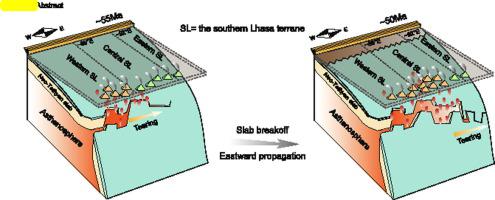Gondwana Research ( IF 7.2 ) Pub Date : 2022-06-11 , DOI: 10.1016/j.gr.2022.05.019 Zhenzhen Wang , Zhidan Zhao , Paul D. Asimow , Xuping Li , Yuanku Meng , Dong Liu , Xuanxue Mo , Di-Cheng Zhu , Yan Tang , Fuyun Cong

|
Past geodynamic events can be reconstructed using the spatial and temporal patterns of geochemical variability in igneous rocks. Here we apply this principle to define the timing and geometry of breakoff of the Neo-Tethyan slab after the India-Asia collision. Two episodes of mafic magmatism (∼53 Ma and ∼ 48 Ma) are preserved in the Quxu area of the southern Lhasa terrane (SL). We present their whole-rock geochemistry, zircon U-Pb ages, and in situ zircon Hf isotope ratios. The early gabbro (∼53 Ma) exhibits typical arc basalt characteristics, including enrichment of large-ion lithophile elements (LILEs), depletion of high-field strength elements (HFSEs), and radiogenic Nd and zircon Hf isotopes, implying that they were formed by partial melting of metasomatized lithospheric mantle. In comparison to the early gabbro, the late hornblende gabbro (∼48 Ma) contains higher contents of HFSEs (e.g., Nb, Zr) and relatively less radiogenic Nd and zircon Hf isotopes, suggesting interaction between the enriched sub-continental lithospheric mantle and asthenospheric mantle. It is likely that upwelling asthenosphere reached the central SL around 50 Ma and that the Neo-Tethyan slab tore off under this area at this time. The spatial and temporal distribution of mafic rocks across the whole southern Lhasa terrane show that this geochemical transition and hence, presumably, the tearing off of the Neo-Tethyan slab, propagated eastward along the collision zone throughout Paleocene-Eocene time.
中文翻译:

拉萨南段始新世镁铁质岩浆作用的两次事件表明板片断裂向东传播
过去的地球动力学事件可以使用火成岩地球化学变化的空间和时间模式来重建。在这里,我们应用这一原则来定义印度-亚洲碰撞后新特提斯板块断裂的时间和几何形状。在拉萨地体南部(SL)的曲徐地区保存了两期镁铁质岩浆作用(~53 Ma和~48 Ma)。我们介绍了它们的全岩地球化学、锆石 U-Pb 年龄和原位锆石 Hf 同位素比。早期辉长岩(~53 Ma)表现出典型的弧形玄武岩特征,包括大离子亲石元素(LILEs)的富集,高场强元素(HFSEs)的耗尽,以及放射性Nd和锆石Hf同位素,暗示它们是形成的通过交代岩石圈地幔的部分熔融。相比 早期辉长岩、晚期角闪石辉长岩(~48 Ma)含有较高含量的 HFSE(例如 Nb、Zr)和相对较少的放射性 Nd 和锆石 Hf 同位素,表明富集的次大陆岩石圈地幔和软流圈地幔之间存在相互作用。上升的软流圈很可能在 50 Ma 左右到达中央 SL,此时新特提斯板块在该区域下方撕裂。整个拉萨南部地体的镁铁质岩石的时空分布表明,这种地球化学转变以及由此推测的新特提斯板块的撕裂,在整个古新世-始新世时期沿着碰撞带向东传播。











































 京公网安备 11010802027423号
京公网安备 11010802027423号